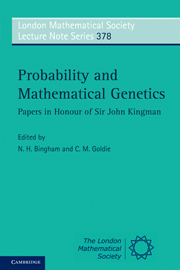Book contents
- Frontmatter
- Contents
- List of contributors
- Preface
- Bibliography of J. F. C. Kingman
- 1 A fragment of autobiography, 1957–1967
- 2 More uses of exchangeability: representations of complex random structures
- 3 Perfect simulation using dominated coupling from the past with application to area-interaction point processes and wavelet thresholding
- 4 Assessing molecular variability in cancer genomes
- 5 Branching out
- 6 Kingman, category and combinatorics
- 7 Long-range dependence in a Cox process directed by an alternating renewal process
- 8 Kernel methods and minimum contrast estimators for empirical deconvolution
- 9 The coalescent and its descendants
- 10 Kingman and mathematical population genetics
- 11 Characterizations of exchangeable partitions and random discrete distributions by deletion properties
- 12 Applying coupon-collecting theory to computer-aided assessments
- 13 Colouring and breaking sticks: random distributions and heterogeneous clustering
- 14 The associated random walk and martingales in random walks with stationary increments
- 15 Diffusion processes and coalescent trees
- 16 Three problems for the clairvoyant demon
- 17 Homogenization for advection-diffusion in a perforated domain
- 18 Heavy traffic on a controlled motorway
- 19 Coupling time distribution asymptotics for some couplings of the Lévy stochastic area
- 20 Queueing with neighbours
- 21 Optimal information feed
- 22 A dynamical-system picture of a simple branching-process phase transition
- Index
17 - Homogenization for advection-diffusion in a perforated domain
Published online by Cambridge University Press: 07 September 2011
- Frontmatter
- Contents
- List of contributors
- Preface
- Bibliography of J. F. C. Kingman
- 1 A fragment of autobiography, 1957–1967
- 2 More uses of exchangeability: representations of complex random structures
- 3 Perfect simulation using dominated coupling from the past with application to area-interaction point processes and wavelet thresholding
- 4 Assessing molecular variability in cancer genomes
- 5 Branching out
- 6 Kingman, category and combinatorics
- 7 Long-range dependence in a Cox process directed by an alternating renewal process
- 8 Kernel methods and minimum contrast estimators for empirical deconvolution
- 9 The coalescent and its descendants
- 10 Kingman and mathematical population genetics
- 11 Characterizations of exchangeable partitions and random discrete distributions by deletion properties
- 12 Applying coupon-collecting theory to computer-aided assessments
- 13 Colouring and breaking sticks: random distributions and heterogeneous clustering
- 14 The associated random walk and martingales in random walks with stationary increments
- 15 Diffusion processes and coalescent trees
- 16 Three problems for the clairvoyant demon
- 17 Homogenization for advection-diffusion in a perforated domain
- 18 Heavy traffic on a controlled motorway
- 19 Coupling time distribution asymptotics for some couplings of the Lévy stochastic area
- 20 Queueing with neighbours
- 21 Optimal information feed
- 22 A dynamical-system picture of a simple branching-process phase transition
- Index
Summary
Abstract
The volume of a Wiener sausage constructed from a diffusion process with periodic, mean-zero, divergence-free velocity field, in dimension 3 or more, is shown to have a non-random and positive asymptotic rate of growth. This is used to establish the existence of a homogenized limit for such a diffusion when subject to Dirichlet conditions on the boundaries of a sparse and independent array of obstacles. There is a constant effective long-time loss rate at the obstacles. The dependence of this rate on the form and intensity of the obstacles and on the velocity field is investigated. A Monte Carlo algorithm for the computation of the volume growth rate of the sausage is introduced and some numerical results are presented for the Taylor–Green velocity field.
AMS subject classification (MSC2010) 60G60, 60G65, 35B27, 65C05
Introduction
We consider the problem of the existence and characterization of a homogenized limit for advection-diffusion in a perforated domain. This problem was initially motivated for us as a model for the transport of water vapour in the atmosphere, subject to molecular diffusion and turbulent advection, where the vapour is also lost by condensation on suspended ice crystals. It is of interest to determine the long-time rate of loss and in particular whether this is strongly affected by the advection. In this article we address a simple version of this set-up, where the advection is periodic in space and constant in time and where the ice crystals remain fixed in space.
- Type
- Chapter
- Information
- Probability and Mathematical GeneticsPapers in Honour of Sir John Kingman, pp. 397 - 415Publisher: Cambridge University PressPrint publication year: 2010
- 1
- Cited by

